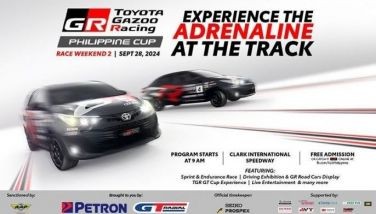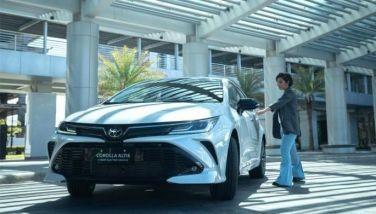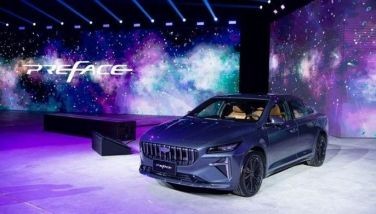Toyota and Lexus at the 2009 Tokyo Motor Show
MANILA, Philippines - Major American and European manufacturers may have snubbed the Tokyo Motor Show, but for the Japan Automobile Manufacturers Association it was still the best time yet to show to the home market and the world that the industry may be down, but definitely not out. Only several weeks after its current president Akio Toyoda had issued a contrite, SONA-like public apology (only more sincere) to the Japan Press Club for its shortcomings in the face of a worldwide economic downturn, the world’s number one brand unveiled a trio of exciting concept vehicles that looked to be ready for production in a few year’s time. Following the politically correct tone of environmentally friendly vehicles in the age of global warming, two of the three were alternative-fuel vehicles. The third, however, showed a dash of color and flash to prove that Toyota still knows what driving enthusiasm is all about. Toyota also took the opportunity to unveil its newest hybrid production vehicle, the Sai, while its luxury brand Lexus also unveiled the LF-Ch concept luxury-hybrid and the limited production LFA supercar.
Prius Plug-In Hybrid – Based on the wildly popular, third-generation Pris, the Plug-In Hybrid Concept is the first Toyota-brand vehicle to use lithium-ion batteries. Capable of being charged from an external power source such as a household outlet, it can operate with or without a battery charge, making it a viable option even without a battery-charging infrastructure. Battery charging times are just 180 minutes on a 100V outlet, or just 100 minutes at 200V, making it as convenient to charge as a cellular phone. More efficient batteries than the production Prius give it improved fuel efficiency with reduced CO2 emissions and lower atmospheric pollution. Claimed fuel efficiency goals are at least 55km/l, C02 , emissions of 42g/km or less, and an EV cruising range of 20km or more with a fully charged battery.
 FT-EV II – A compact Electric Vehicle designed for short commutes, it’s based on the premise that EVs will be mainstream vehicles in the future, and that transportation means will be divided according to purpose, energy means, and the energy supply infrastructure. Just 2,730mm. long, 1,680 mm. wide, 1,490 mm. tall, and with a wheelbase of 1,900mm., the FT-EV II is even smaller than Toyota’s incredibly cute, production “iQ” microcar.
FT-EV II – A compact Electric Vehicle designed for short commutes, it’s based on the premise that EVs will be mainstream vehicles in the future, and that transportation means will be divided according to purpose, energy means, and the energy supply infrastructure. Just 2,730mm. long, 1,680 mm. wide, 1,490 mm. tall, and with a wheelbase of 1,900mm., the FT-EV II is even smaller than Toyota’s incredibly cute, production “iQ” microcar.
The FT-EV II takes advantage of drive-by-wire technology to create 4-passenger capacity. A joystick is used to operate the accelerator, brakes, and steering, thus eliminating the space-eating requirements of accelerator pedal, brake pedals, and steering column.
The vehicle features a low front cowl and an auxiliary window below the windshield for outstanding forward visibility (rather like a bus’). Even the LED rear combination taillights are see-through for enhanced rearward visibility.
Electric sliding doors on both sides facilitate ingress and egress, a boon to congested urban environments.
With a fully-charged battery it has a range of over 90km, making it ideal for everyday use. The top speed of over 100kph should satisfy most urban guerrilla needs.
 FT-86 – Hachi roku! Harkening back to the glory days of the Celica, the MR2, and particularly the Corolla AE86, the FT-86 (“86” pronounced as “hachi roku”) is a compact 4-seat, rear-wheel drive sports car that looks ready for production in a few years.
FT-86 – Hachi roku! Harkening back to the glory days of the Celica, the MR2, and particularly the Corolla AE86, the FT-86 (“86” pronounced as “hachi roku”) is a compact 4-seat, rear-wheel drive sports car that looks ready for production in a few years.
The sleek design features a serpentine face, muscular flanks, and a minimalist cabin.
It’s powered by a 2-liter horizontally opposed engine said to be sourced from Subaru.
After the modest success of the Supra in the last decade, which boasted of Corvette-caliber performance but was criticized for being overpriced and overweight, the FT-86 is a second attempt at sports car success, this time aiming for lightness and a lower sticker price.
 Sai – A sai is best known among laymen as a short knife-like weapon used in pairs by fictional characters like Teenage Mutant Ninja Turtle Rafael and Elektra, but it’s actually Japanese for “talent”. In Toyota’s case, it’s the name for a production, hybrid-only sedan combining “advanced talent and multi-color sophistication”. Translation: it’s green-tech like the Prius, but more luxuriously appointed. The Sai features a gasoline-electric hybrid system with a 2.4-liter engine for outstanding fuel efficiency, and approximately 60% of the interior surface area uses Ecological Plastic (made from plant-derived materials).
Sai – A sai is best known among laymen as a short knife-like weapon used in pairs by fictional characters like Teenage Mutant Ninja Turtle Rafael and Elektra, but it’s actually Japanese for “talent”. In Toyota’s case, it’s the name for a production, hybrid-only sedan combining “advanced talent and multi-color sophistication”. Translation: it’s green-tech like the Prius, but more luxuriously appointed. The Sai features a gasoline-electric hybrid system with a 2.4-liter engine for outstanding fuel efficiency, and approximately 60% of the interior surface area uses Ecological Plastic (made from plant-derived materials).
The Toyota Hybrid System (THS) II combines a 2.4-liter Atkinson cycle combustion engine with an electric motor and reduction gear. By delaying intake valve closure, the engine achieves a high expansion ratio at low pressure, thus raising heat efficiency. Under the 10-15 test cycle of the Japanese Ministry of Land, Infrastructure, Transport, and Tourism, it has a fuel efficiency of 23 km/l to put it on par with 660cc minivehicles. Under the MLIT’s JC08 test vehicle, the Sai achieves 19.8 km/l. It also meets the 2015 Japanese fuel efficiency standards with C02 emissions that are 75% lower than 2005 standards, which is currently the strictest standard in Japan for emissions, thus qualifying the Sai for Japanese government tax reductions and subsidies.
Like the Prius, the Sai has a real-time status indicator for the Hybrid System. An ESPO (derived from “eco” and “passport”) system also encourages and rewards environmentally considerate driving. The G-BOOK mX advanced telematics service assesses environmentally considerate driving and awards points to the driver; mastery of eco-driving can be determined according to the number of points gained each month. Programs can then allow drivers to make donations to charities using points received with the system. The Sai also bristles with enhanced safety equipment, including 7 SRS airbags, a millimeter wave radar to help prevent front and rear collisions, lane-keeping assistance with corrective steering, and even a wide-view front monitor to display the ground hidden below the windshield cowl.
 Lexus LF-Ch – The LF-Ch is a full hybrid, five-door concept meant to show that “green” doesn’t necessarily have to mean “dull”.
Lexus LF-Ch – The LF-Ch is a full hybrid, five-door concept meant to show that “green” doesn’t necessarily have to mean “dull”.
A wide stance, long wheelbase, low center gravity, and taut bodywork with an intriguing, gold-yellow paint job give it a luxurious yet athletic appearance.
The cabin features a Remote Touch interface for centralized control of navigation, entertainment, and climate systems.
Semi-aniline leather, polished aluminum, wood, soft-touch materials, and seats with exposed metal frames inspired by high quality furniture give the LF-Ch a very chic, designer feel.
The Lexus Hybrid Drive technology features four settings: Normal, Eco, EV, and Sport.
The fully electric EV mode enables urban driving with minimal noise and zero emissions.
 Lexus LFA – With the LFA, Lexus is telling the world of sheiks, tycoons, Internet billionaires, and sports car fan-boys that they can also make a supercar just like Lamborghini, Ferrari, and other high-octane marques.
Lexus LFA – With the LFA, Lexus is telling the world of sheiks, tycoons, Internet billionaires, and sports car fan-boys that they can also make a supercar just like Lamborghini, Ferrari, and other high-octane marques.
Except that the LFA is more exclusive. The 2-seater began life as a concept in 2000, so it’s surprising that the marque decided to make a street-worthy version anyway, albeit with a limited production run of just 500.
Featuring a midship engine-rear transaxle layout, the $375,000 LFA looks ready to star in the next Spielberg sci-fi and is powered by a 560-horsepower, 9000 RPM V10 mated to a 6-speed sequential transmission.
Front-rear weight balance is 48:52. As Lexus’ high-performance flagship, the LFA features exotic components like carbon-ceramic brakes; a Carbon Fiber Reinforced Plastics cabin and subframe derived from aerospace and motorsports designs said to be 100 kilos lighter than an aluminum equivalent; shock absorber piston rods coated in a diamond-like carbon compound; forged aluminum knuckles, suspension arms, and carriers; and an exquisitely designed exhaust system to create an unforgettable engine sound.
An equal-length exhaust system, multi-stage main muffler, and strategically placed sound passages that pipe the induction sound directly into the cabin create an orchestra-like harmony of V10 sound and fury. Production begins in 2010 and ends in 2012, with each unit made-to-order.
- Latest






























